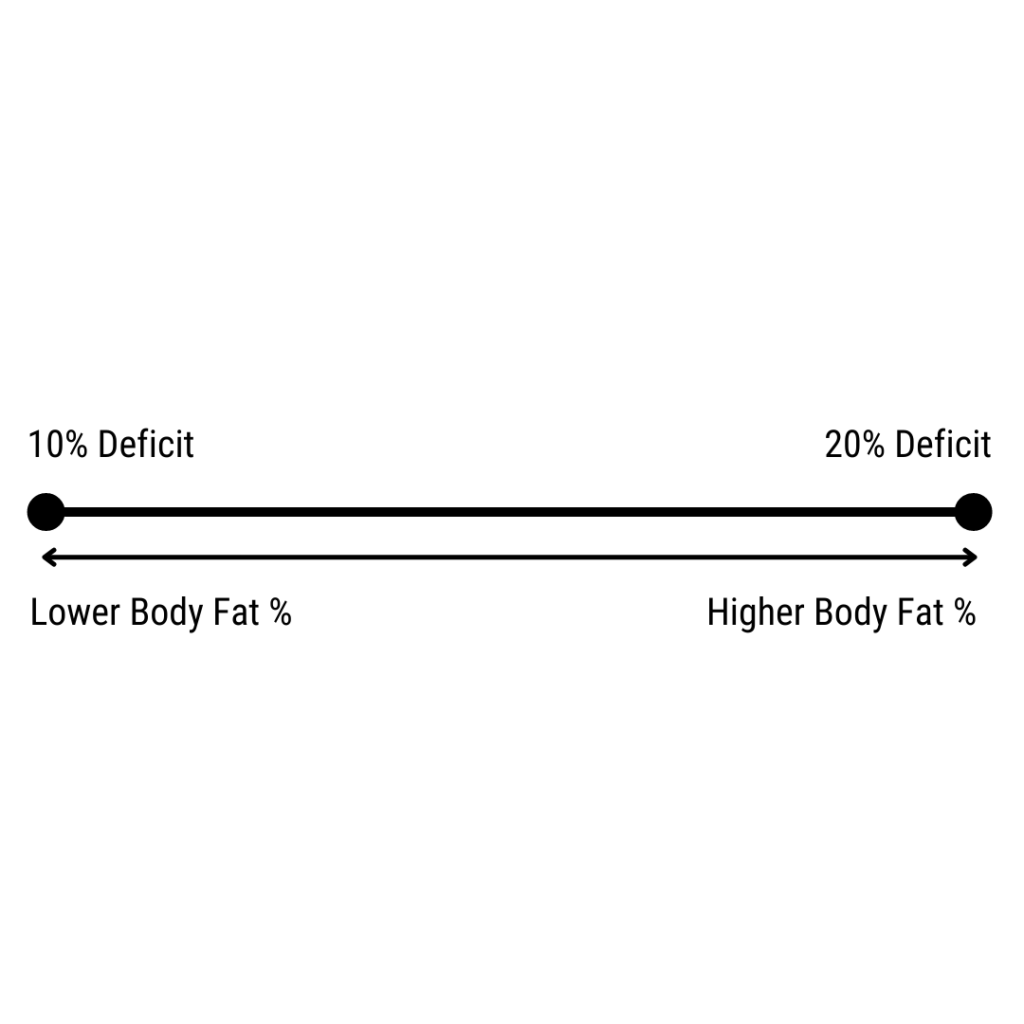How Many Calories Should I Eat to Lose Weight?

Table of Contents
- Calculate Your BMR
- Calculate Your TDEE
- Create a Calorie Deficit
- Monitor Changes In Your Physique
- Make Adjustments As Needed
- My Preference and Recommendation
Calculate Your BMR (Basal Metabolic Rate)
Your BMR, or basal metabolic rate, is the number of calories your body burns performing the most basic life sustaining functions like pumping blood throughout your body, breathing, temperature regulation, and more. It’s the amount of calories you’d burn at complete rest over a 24-hour period.
There are numerous BMR formulas, but the Mifflin-St Jeor equation and the Harris-Benedict equation are the two most popular one’s due to their accuracy.
They will both result in slightly different numbers, but both are great starting points.
You can use both equations and take the average of the two, or use one or the other.
Once you find your BMR using one or both of the equations below, you’ll then use your BMR to find your TDEE.
Keep in mind the human body is very complex, and you can’t always get exact values by simply punching numbers into a formula. There are so many factors that can influence one’s metabolic rate. Sometimes people’s actual metabolic rate is higher or lower than predicted.
For most people, these will be fairly accurate.
Harris-Benedict Equation
- Men: 88.362 + (13.397 × weight in kg) + (4.799 × height in cm) – (5.677 × age in years)
- Women: 447.593 + (9.247 × weight in kg) + (3.098 × height in cm) – (4.330 × age in years)
Mifflin-St Jeor Equation
- Men: (10 × weight in kg) + (6.25 × height in cm) – (5 × age in years) + 5
- Women: (10 × weight in kg) + (6.25 × height in cm) – (5 × age in years) – 161
Calculate Your TDEE (Total Daily Energy Expenditure)
To make it easier and avoid any mistakes while doing the math by hand, I’d suggest using this BMR and TDEE calculator. I’ve been using this, and I find it’s reasonably accurate. This calculator uses the Harris-Benedict equation.
When you hit “Calculate!” you’ll see it gives you your estimated BMR and your daily calorie needs, which is your TDEE.
Here is another great calculator. On this one, you’ll have to choose “Advanced Mode” to include your activity level and find your TDEE. If it says “Simple Mode” you’re already in advanced mode.
I used both calculators, and they were very close. The difference was only 52 calories when I entered my information.
If you rather do the math by hand, you can enter your age, height, and weight into one of the equations above. Then you’d find your TDEE by multiplying your BMR by one of the values below.
- Sedentary (little to no exercise + work a desk job) = 1.2
- Lightly Active (light exercise 1-3 days/week) = 1.375
- Moderately Active (moderate exercise 3-5 days/week) = 1.55
- Very Active (heavy exercise 6-7 days/week) = 1.725
- Extremely Active (strenuous training 1-2x/day + labor intensive job) = 1.9
Make sure you’re being very honest with how active you are, and the intensity of your exercise. It’s important to use the correct values.
Once you’ve found your TDEE, that is the estimated number of calories your body needs to maintain your current weight at your current activity level. This is what you would call your maintenance calories.
Since there’s room for error when calculating your BMR, there’s also room for error in calculating your TDEE, especially when you consider a lot of people consider themselves more active than they really are. Sure, you might show up to the gym 6 days a week, but how hard are your workouts?
Creating a Calorie Deficit
You’ll often see the recommendation of cutting 500 calories from your diet in order to lose 1 pound per week.
Why 500 calories?
There are about 3,500 calories in 1 pound of fat.
So if you are in a 500 calorie deficit 7 days a week, by the end of the week you end up in a 3,500 calorie deficit, and hopefully lose 1 pound of fat.
-500 calories per day x 7 days per week = -3,500 calories per week = 1 pound of fat
You can do this, and it can work, but there are two other common methods for deciding what your starting calories should be for your cut.
Let’s take a look at both.
Using Goal Rate of Weight Loss and Body Weight
First, I should mention that the recommended rate of weight loss per week is 0.5 to 1% of your body weight per week.
A rate of weight loss of 1% of your body weight per week should be used for those that are obese, over 25% body fat.
Most people should aim for a rate of weight loss of 0.5-0.75% of their body weight each week.
This study took two groups of athletes. One group lost weight at a rate of 0.7% of their body weight each week, and the other lost 1.4% of their body weight each week.
The group that lost 0.7% of their body weight each week lost body fat, gained muscle, and gained more strength than the faster rate of weight loss group.
The fast weight loss group, losing 1.4% of their body week per week, didn’t gain any muscle, lost about the same amount of body fat, and didn’t gain as much strength.
A slower rate of weight loss is better for maintaining or even continuing to build muscle and strength while losing weight, which is what we all want.
Those who are starting at a lower body fat percentage will want to lose less of their body weight each week, closer to 0.5%. As you get leaner your risk of muscle loss increases as you continue to lose body fat. Losing weight at a slower rate can help prevent that.
Those who are starting at a higher body fat percentage can get away with losing more of their body weight each week, closer to 1%.
Those who are very overweight and have lots of fat to lose can lose more of their body weight per week. Their energy stores are high (in the form of extra body fat) and the chances they’ll lose muscle at this stage are small. This group can lose closer to 1% of their body weight each week if they can sustain that size of a calorie deficit.
Let’s say you’re 215 pounds at 14% body fat, and you want to lose 0.5% of your body weight each week.
- 215 pounds x 0.005 = 1. 075 pounds per week
- 1.075 pounds per week x 500 calories = 537.5 calories per week rounded to 530 or 540.
If 3,000 calories is your TDEE, the amount of calories to maintain your weight, you’d subtract 530 or 540 calories from 3,000 calories to get you starting point for your cut.
- 3,000 calories – 530 calories = 2,470 calories
The body fat percentage of 14% I provided was not used in the calculation. I included body fat percentage to give an idea what this persons body composition was like, and what rate of weight loss would be best. If this person was 25% body fat, I would have used a rate of weight loss of 1% of their body weight per week to start.
This should provide a good starting point for you. After 2-3 weeks of consuming this number of calories you can make any adjustments if needed.
Using a 10-20% Calorie Deficit
Another common method is to take 10-20% of your TDEE (maintenance calories), and make that your deficit.
If your TDEE is 3,000 calories, you can take 10% of that, and subtract it from 3,000.
- 3,000 calories x .10 = 300 calories
- 3,000 calories – 300 calories = 2,700 calories
2,700 calories would be your starting calories.
If you wanted to lose weight a bit faster by creating a larger deficit, you could use a 15% deficit.
- 3,000 calories x .15 = 450 calories
- 3,000 calories – 450 calories = 2,550 calories
2,550 calories would be your starting calories if you used a 15% deficit.
In most cases, I rather start at a smaller deficit and try to get away with consuming as many calories as possible and still losing body fat. If you’re not losing weight fast enough, you can always subtract another 100 calories, give it a couple weeks, and track your results.
Here’s a good graphic representing how I’d suggest going about using this method. The lower the body fat percentage you are, the closer to a 10% deficit you’ll use. The more body fat you have to lose, the closer you can be to a 20% deficit.

Monitor Changes In Your Physique
Here are some ways you can keep on eye on your progress and how your physique is changing:
- The scale
- First thing in the morning, no food or water yet, after using the bathroom, no clothes.
- Progress pictures
- Keep all variables as consistent as possible (distance standing from camera, lighting, angle, time of day, preferably first thing in the morning with no food or water yet and after using the bathroom).
- The mirror
- This can be tough because it can be difficult to notice subtle changes when you see yourself nearly every day. Some can notice the slightly differences in their appearance day-to-day.
- Body part measurements
- Use a tape measure. First thing in the morning, no food or water yet, after using the bathroom. There is room for human error in this method. Maybe you didn’t pull tight enough on the tape to close any gaps, or you were measuring your chest and waist and didn’t realize the tape twisted behind your back. I’d take each measurement 2-3 times to make sure they’re accurate.
- How your clothes fit
- If your clothes are fitting better despite your weight not changing, that’s a good sign. Muscle is more dense than fat, so fat takes up a lot more space. If the scale is not moving, but your clothes aren’t as tight and they’re fitting better, you’re probably building muscle and losing fat.
I rarely recommend getting a body fat test done because many of them, especially the easily available ones like the scale you step onto and handles you hold, are very inaccurate. These are done using a method called bioelectrical impedance.
More accurate methods include the 7-site skin fold method with skin calipers (do it 3 times at each spot, take the average), DXA scan, hydrostatic weighing, and air displacement (Bod Pod).
Make Adjustments As Needed
Keep eye on the changes taking place, and make adjustments when they’re necessary.
If you’re losing weight at just the right rate, keep eating that much.
If you’re losing weight too slowly, subtract 100 calories, give it a couple weeks, and adjust again if needed. Make sure you’re being realistic. I’ve seen many people make great progress and they’re losing weight at a normal rate, but they’re unrealistic expectations take over and they’re disappointed when they should be proud.
If you’re losing weight too fast, add 100 calories back into your diet. After a few weeks you can reevaluate your progress and make changes if needed.
Keep in mind that as you spend time in a calorie deficit and drop body fat, your calorie needs will change as your body changes.
You will hit plateaus, and weight lose will slow down, or come to a complete stop. So what once was a deficit for you, may no longer be a deficit, and now might be your new maintenance. Adjustments need to be made.
There are many different dietary strategies you can use, but it still comes down to creating a deficit by either consuming less calories, burning more calories, or a bit of both.
My Preference and Recommendation
Slower weight loss has been proven to reduce the risk of muscle loss and lessen the effects of metabolic adaptation. A slower rate of weight loss means a more moderate calorie deficit.
When your calorie deficit isn’t too large, it’s often easier to be consistent with your nutrition, and consistency is key for achieving just about anything, including weight loss.
So, I frequently use the 10-20% calorie deficit rule because it usually results in a smaller calorie deficit, and in most cases, I rather start with that approach. I’d rather try to get away with consuming as many calories as possible while losing fat, than to start with too aggressive of a deficit, eating less than you have to, and possibly even having to add calories back into your diet.

However, there is a time when a more aggressive approach and fast weight loss can be beneficial.
If someone is obese (over 25% body fat) and experiencing many health issues, losing weight faster can help alleviate the health issues and get them healthier sooner.
People with more body fat can get away with losing weight faster with hardly any negative side effects. Losing 1%, or even up to 1.25% of their body weight each week is doable when starting out.
Also, for those that are very overweight, fast fat loss in the beginning can be very motivating. They love seeing the scale go down, and they know what they’re doing is working. They’re seeing results, so they want to keep going, and being consistent is easier. It’s not uncommon for people to get easily discouraged by slow progress, or no progress at all.
Go at whatever pace that allows you to be consistent.
And remember, in most cases the goal shouldn’t be strictly weight loss, but it should be fat loss. For most of us, slow and steady often comes out on top and leads to better long-term outcomes.
If you could use some professional guidance on setting up your fat loss plan, fill out the online coaching application form below, and I’ll get back to you as soon as I can with the next steps!
